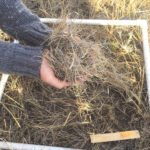
Tag Archives Pasture

Ranchers rewarded for preserving species at risk on native range
Sask. producers find balance between beef production and nature
Beef producers in southwestern Saskatchewan are being rewarded for ensuring that species at risk have a home on native pastures. Tom Harrison is a rancher and executive director of the South of the Divide Conservation Action Program Inc. (SODCAP), an organization founded in 2014 to create and maintain habitat for species at risk on native […] Read more

Do RFI ratings predict cattle performance on pasture?
In a word, no
Producers often wonder if genetic markers for feed efficiency based on drylot tests reflect feed efficiency on pasture where terrain, water sources and plant diversity are very different from a pen setting. Genetic markers for residual feed intake (RFI) have been identified that correlate well with actual RFI determined during the standard trials in pens […] Read more

PastureMap: a digital ranch hand
Grazing management software helps track pasture performance
PastureMap is grazing management software sold around the world that got its start in no small measure because of Christine Su’s lifelong struggle with food allergies. “This drove me to try to source beef and dairy products from local farmers and ranchers that I knew, here in California. This opened my eyes to how complex […] Read more

A plug for grass-legume mixes for grazing
An ideal pasture depends on the goals of the producer
Research over the years in various regions has looked at the potential and advantages of grass-legume mixtures for pasture. A diversified pasture stand allows for different plants to thrive in different conditions, adding drought resistance. Legumes have a deep tap root and can penetrate deeper into the soil profile where there’s more moisture. Pastures with […] Read more

Putting science into grass management
The Grazing Response Index scores foliage removal, grazing period and recovery time
When it came out of Colorado in the 1990s, the Grazing Response Index (GRI) was strictly at home on the range. Now Ducks Unlimited Canada’s Jodie Horvath says that, with a few tweaks, the grass management tool can help graziers on Western Canada’s tame pastures, too. “When you’re a farmer, a lot of things feel […] Read more

Proper timing of pasture turnout critical for drought recovery
Grazing cattle too early can end up reducing your stocking rate
North Dakota’s drought-stressed pastures, especially pastures stressed during the fall of 2017, should receive special care this spring to help them recover from the drought, North Dakota State University Extension Service grazing experts advise. “It is critical that these pastures are given adequate time to recover,” says Miranda Meehan, livestock environmental stewardship specialist. “Grazing too […] Read more

Legumes are best, but…
Nova Scotia researchers are looking at ways to maintain their percentage in forage mixtures under grazing
Not only are legumes a superfood for humans, but they are a superfood for cattle too. In fact, regardless of what type of livestock producers raise, the animals perform better on a diet of grass mixed with legumes than if just on a diet of straight grass, resulting in better weight gain and increased milk […] Read more

Wildfire-damaged grazing areas up for Saskatchewan aid
Saskatchewan’s provincial disaster assistance program (PDAP) will be opened up to cover southwestern grazing areas damaged by this fall’s wildfires. The province’s government relations minister, Larry Doke, on Wednesday announced producers who incurred wildfire damage on “tame and native lands” intended for grazing may now apply for assistance to get feed for affected livestock. Winds […] Read more

The economics behind bale grazing
Grazing with Steve Kenyon
I started bale grazing in 1999 and have had many producers over the years thank me for sharing my bale grazing information with them. The usual comment is that they will never go back to the traditional method of feeding cattle. For me, bale grazing was a no-brainer once I looked at the cost savings. […] Read more

GRI gets the green light for tame pastures
Forage: News Roundup from the June 2017 issue of Canadian Cattlemen
Putting numbers to three observations that form the Grazing Response Index (GRI) will give you a good idea as to whether your management practices will benefit, harm or have no effect on plant health in the long run. If the scores for grazing intensity, grazing frequency, and opportunity for regrowth during the growing season on […] Read more



